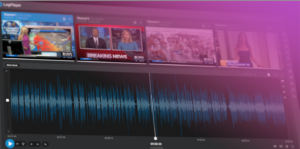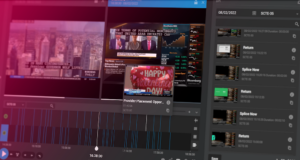
The year of getting everything connected

The ongoing digital transformation of broadcasting – and media in general – has seen the coming together of technologies that are now being applied to different parts of the broadcast chain, from production through to distribution. Among these is increased automation and remote access, combined with artificial intelligence/machine learning (AI/ML) and native cloud operations.
In all of this, monitoring and compliance with regulatory standards to ensure quality of service (QoS) will play major roles.
OTT delivery has been dominating both the discussion and the media landscape over the last five years. This is set to continue in 2023 and for some time to come as streaming expands its reach further into broadcasting, with news being the latest area of implementation. The evolution of OTT is perhaps illustrated more by the growth in the number of FAST (free ad supported TV) channels now appearing on streamed platforms. This is part of the continuing growth and development of OTT, with a general explosion of content and live streams that are now on the internet rather than traditional transmissions such as terrestrial, cable and satellite.
Streaming Protocols and Technical Standards are Proliferating
The inherent challenge in this for broadcasters and service providers is to cope with many variations of current streaming protocols and technical standards. The standardization recommended by SMPTE and SCTE has, to a large extent, been undermined by Apple and Google, which are effectively setting standards today.
This is because they own the web browsers and mobile devices that receive broadcasts and OTT. As part of this there is now the prospect of increased use of protocols based on the HTTP (Hypertext Transfer Protocol) internet standard, including HLS (HTTP Live Streaming), particularly for live pop-up streams, and MPEG-DASH (Dynamic Adaptive Streaming over HTTP).
The Growing Need for Comprehensive Monitoring Solutions
Other considerations are ‘contribution’ protocols, including SRT (Secure Reliable Transport), Zixi and RIST (Reliable Internet Stream Transport). The problem here is that there are differences in the delivery, distribution and formatting for video and audio, with ancillary data such as closed captions and digital program insertion triggers further complicating matters. This will call for comprehensive monitoring solutions to deal with variants as they appear and ensure a consistent output.

Comprehensive monitoring solutions must deal with variants as they appear and ensure a consistent output.
A major change in the streaming sector has been the decision by streaming services, including Amazon Prime, which originally set the subscription-only template for OTT, to move into FAST while maintaining their existing subscriber models. The general growth of FAST will see more reliance on dynamic ad insertion (DAI) to ensure that the right commercials are triggered at the right time on each platform and device.
The Next Step in Personalization
DAI additionally offers the ability to deliver targeted advertising, which ties into another key trending feature that broadcasters and streamers alike are implementing – personalization. Platforms are already able to identify viewer interests and preferences, the most familiar being lining up the next episode in a series and suggesting similar programs.

OTT services must not suffer latency or buffering between the video content and ads, instead presenting a continuous, seamless output
As with the evolution of AI, the aim is to take personalization further by combining it with greater connectivity between users and their preferred media platforms. This way, it will be possible to apply the information gathered about viewers and make it work for them by enhancing the viewing experience and their lives in general. In both instances, it is imperative that the OTT service does not suffer any latency or buffering between the video content and ads, instead presenting a continuous, seamless output.
The Goal: Quality and Timeliness in Handling Data and Delivering Services
The increasing flexibility of production techniques, including remote operations, is further enabling development, with the cloud giving organizations the power to make programs anywhere without the need for expensive broadcast premises or facilities. Virtual and cloud-based production were happening pre-2020, with the lockdowns necessitated by Covid accelerating adoption of this way of working.
The migration to the cloud is now in full swing and while this does not mean on-prem operations are being abandoned, there will probably be a hybrid situation that allows production teams to select what works best for their requirements.
Running systems natively in the cloud is set to become an integral part of how broadcasters and streaming services operate. Even though such technologies are more IT than TV, traditional engineering skills and know-how are still necessary to make things work. Underpinning this are technical standards, most pertinently SMPTE ST 2110 for the building of secure, scalable workflows and ATSC 3.0 to enable greater interactivity.
The goal now for broadcasters and facilities is to achieve both quality and timeliness in handling data and delivering services. Compliance technology plays a key role in guaranteeing both, with logging and monitoring systems providing a solid backbone for the continuing progress being made in broadcasting technology.
Erik Otto is CEO of Mediaproxy
































Comments (0)